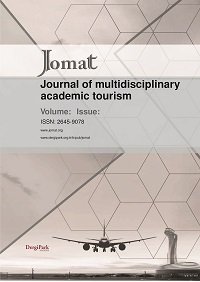Nicholas HRYHORCZUK, Alexander ZVİNCHUK, Zoreslava SHKİRYAK-NYZHNYK, Ludmila SLOBODCHENKO, Alla MATSOLA, Daniel HRYHORCZUK
Engagement in Tourism and Personality Traits among Ukrainian Adolescents
The aim of this paper was to determine if there is an association between personality traits and engagement in tourism among Ukrainian adolescents. The study population consisted of 1075 adolescents and their mothers/caregivers who participated in the Family and Children of Ukraine birth cohort study. The adolescents self-reported how they prefer to spend their leisure time and also completed the revised Eysenck Personality Inventory (EPI). We found that engagement in tourism was significantly associated with better school performance and higher socioeconomic status. Adolescents who engage in tourism also had significantly higher Extraversion and lower Neuroticism scores on the EPI. The associations of tourism engagement with these personality traits remained significant after adjusting for age, gender, socioeconomic status, and school performance. We conclude that personality traits are important predictors of Ukrainian adolescents’ engagement in tourism
Keywords:
Tourism, Personality, Ukraine, Adolescent,
___
- Aluja, A., Garcia, O., & Garcia, L.F. (2003). Relationships among extraversion, openness to experience, and sensation seeking. Personality and Individual Differences, 35, 671-680.
- Eysenck, H. J., & Eysenck, S. B. G. (1969). Personality Dimensions in Children Personality Structure and Measurement (First ed., pp. 265-316). San Diego, California: Robert Kanpp.
- Eysenck, H. J. (1990). Biological dimensions of personality. In L. A. De Pervin (Ed.), Handbook of personality: theory and research (pp. 246). New York: Guilford.
- Lepp, A., & Gibson, H. (2008). Sensation seeking and tourism: Tourist role, perception of risk and destination choice. Tourism Management, 29, 740-750.
- Hoxter, A., & Lester, D. (1987). Personality correlates of allocentrism versus psychocentrism in choice destination for travel. Psychological Reports, 60, 1138.
- Hoxter, A., & Lester, D. (1988). Tourist behavior and personality. Personality and Individual Differences, 9, 177-178.
- Leiper, N. (1995). Tourism Management. Collingwood, Victoria: TAFE Publications.
- Li, C.-Y., Lu, S.-Y., & Tsai, B.-K. (2015). The impact of extraversion and sensation seeking on tourist role. Society for Personality Research, 43(1), 75-84.
- Litvin, S. (2008). Sensation seeking and its measurement for tourism research. Journal of Travel Research, 46, 440-445.
- Matolin, T.V. (1998) Method of express - diagnostics of characterological traits of personality. In D.Ya. Raigorodsky (Ed.) Practical psychodiagnostics. Methods and tests. (pp.672) Samara: Publishing House "Bakhrakh".
- McDonnell, I. (1994). Leisure travel to Fiji and Indonesia from Australia 1982-1992: Some factors underlying changes in market share. Unpublished master’s thesis, University of Technology, Sydney, NSW.
- Nickerson, N. P., (1989). “Tourism and Personality: A comparison of Two Models.” Ph.D. diss., University of Utah.
- Nickerson, N. P., and G. D. Ellis (1991). “Traveler Types and Activation Theory: A Comparison of Two Models.” Journal of Travel Research, 29 (Winter): 26-31.
- Pizam, A., Jeong, G., Reichel, A., Van Boemmel, H., Lusson, J., Steynberg, K., et al. (2004). The relationship between risk taking, sensation seeking and the tourist behavior of young adults: A cross cultural study. Journal of Travel Research, 42, 251-260.
- Plog, S. (1972). Why destination areas rise and fall in popularity. The Cornell Hotel and Restaurant Administration Quarterly, 14(4), 55-58.
- Poria, Y., and Timothy, D. J. (2014). Where are the children in tourism research? Annals of Tourism Research, 47, 77-95.
- Roth, M., Schumacher, J., & Brahler, E. (2005). Sensation seeking in the community. Sex, age and sociodemographic comparisons on a representative German population sample. Personality and Individual Differneces, 39, 1261-1271.
- Smith, S. L. J. (1990). “A Test of Plog’s Allocentrism/Psychocentrism Model: Evidence from Seven Nations.” Journal of Travel Research, 28 (Spring): 40-43.
- Wang, W., Wu, Y.-X., Peng, Z.-G., Lu, S.-W., Yu, L., & Wang, G.-P. (2000). Test of sensation seeking in a Chinese sample. Personality and Individual Differences, 28, 169-179.
- Zuckerman, M. (1979). Sensation seeking: Beyond the optimal level of arousal. Hillsdale, NJ: Erlbaum.
- Yayın Aralığı: 3
- Başlangıç: 2016
- Yayıncı: Yusuf Karakuş
